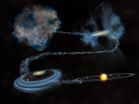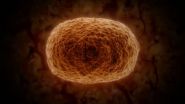(Press-News.org) Washington, D.C.—Water was crucial to the rise of life on Earth and is also important to evaluating the possibility of life on other planets. Identifying the original source of Earth's water is key to understanding how life-fostering environments come into being and how likely they are to be found elsewhere. New work from a team including Carnegie's Conel Alexander found that much of our Solar System's water likely originated as ices that formed in interstellar space. Their work is published in Science.
Water is found throughout our Solar System. Not just on Earth, but on icy comets and moons, and in the shadowed basins of Mercury. Water has been found included in mineral samples from meteorites, the Moon, and Mars.
Comets and asteroids in particular, being primitive objects, provide a natural "time capsule" of the conditions during the early days of our Solar System. Their ices can tell scientists about the ice that encircled the Sun after its birth, the origin of which was an unanswered question until now.
In its youth, the Sun was surrounded by a protoplanetary disk, the so-called solar nebula, from which the planets were born. But it was unclear to researchers whether the ice in this disk originated from the Sun's own parental interstellar molecular cloud, from which it was created, or whether this interstellar water had been destroyed and was re-formed by the chemical reactions taking place in the solar nebula.
"Why this is important? If water in the early Solar System was primarily inherited as ice from interstellar space, then it is likely that similar ices, along with the prebiotic organic matter that they contain, are abundant in most or all protoplanetary disks around forming stars," Alexander explained. "But if the early Solar System's water was largely the result of local chemical processing during the Sun's birth, then it is possible that the abundance of water varies considerably in forming planetary systems, which would obviously have implications for the potential for the emergence of life elsewhere."
In studying the history of our Solar System's ices, the team—led by L. Ilsedore Cleeves from the University of Michigan—focused on hydrogen and its heavier isotope deuterium. Isotopes are atoms of the same element that have the same number of protons but a different number of neutrons. The difference in masses between isotopes results in subtle differences in their behavior during chemical reactions. As a result, the ratio of hydrogen to deuterium in water molecules can tell scientists about the conditions under which the molecules formed.
For example, interstellar water-ice has a high ratio of deuterium to hydrogen because of the very low temperatures at which it forms. Until now, it was unknown how much of this deuterium enrichment was removed by chemical processing during the Sun's birth, or how much deuterium-rich water-ice the newborn Solar System was capable of producing on its own.
So the team created models that simulated a protoplanetary disk in which all the deuterium from space ice has already been eliminated by chemical processing, and the system has to start over "from scratch" at producing ice with deuterium in it during a million-year period. They did this in order to see if the system can reach the ratios of deuterium to hydrogen that are found in meteorite samples, Earth's ocean water, and "time capsule" comets. They found that it could not do so, which told them that at least some of the water in our own Solar System has an origin in interstellar space and pre-dates the birth of the Sun.
"Our findings show that a significant fraction of our Solar System's water, the most-fundamental ingredient to fostering life, is older than the Sun, which indicates that abundant, organic-rich interstellar ices should probably be found in all young planetary systems," Alexander said.
INFORMATION:
This research was supported by the NSF, the Rackham Predoctoral Fellowship, NASA Astrobiology, NASA Cosmochemistry and NASA.
The Carnegie Institution for Science is a private, nonprofit organization headquartered in Washington, D.C., with six research departments throughout the U.S. Since its founding in 1902, the Carnegie Institution has been a pioneering force in basic scientific research. Carnegie scientists are leaders in plant biology, developmental biology, astronomy, materials science, global ecology, and Earth and planetary science.
Earth's water is older than the sun
2014-09-25
ELSE PRESS RELEASES FROM THIS DATE:
Agonizing rabies deaths can be stopped worldwide
2014-09-25
The deadly rabies virus--aptly shaped like a bullet-- can be eliminated among humans by stopping it point-blank among dogs, according to a team of international researchers led by the Paul G. Allen School for Global Animal Health at Washington State University.
Ridding the world of rabies is cost-effective and achievable through mass dog vaccination programs, the scientists report in a paper that appears in the Sept. 26 issue of Science magazine. What's more, they write, because infections occur as a result of interactions between animals and people, a "One Health" approach ...
Heritage of Earth's water gives rise to hopes of life on other planets
2014-09-25
A pioneering new study has shown that water found on Earth predates the formation of the Sun – raising hopes that life could exist on exoplanets, the planets orbiting other stars in our galaxy.
The ground-breaking research set out to discover the origin of the water that was deposited on the Earth as it formed.
It found that a significant fraction of water found on Earth, and across our solar system, predates the formation of the Sun. By showing that water is 'inherited' from the environment when a star is born, the international team of scientists believe other exoplanetary ...
Harvesting hydrogen fuel from the Sun using Earth-abundant materials
2014-09-25
VIDEO:
Science published on Sept. 25, 2014 the latest developments in Michael Grätzel's laboratory at EPFL in the field of hydrogen production from water. By combining a pair of perovskite solar...
Click here for more information.
The race is on to optimize solar energy's performance. More efficient silicon photovoltaic panels, dye-sensitized solar cells, concentrated cells and thermodynamic solar plants all pursue the same goal: to produce a maximum amount of electrons ...
Innovative Stone Age tools were not African invention, say researchers
2014-09-25
A new discovery of thousands of Stone Age tools has provided a major insight into human innovation 325,000 years ago and how early technological developments spread across the world, according to research published in the journal Science.
Researchers from Royal Holloway, University of London, together with an international team from across the United States and Europe, have found evidence which challenges the belief that a type of technology known as Levallois – where the flakes and blades of stones were used to make useful products such as hunting weapons – was invented ...
New discovery could pave the way for spin-based computing
2014-09-25
PITTSBURGH—Electricity and magnetism rule our digital world. Semiconductors process electrical information, while magnetic materials enable long-term data storage. A University of Pittsburgh research team has discovered a way to fuse these two distinct properties in a single material, paving the way for new ultrahigh density storage and computing architectures.
While phones and laptops rely on electricity to process and temporarily store information, long-term data storage is still largely achieved via magnetism. Discs coated with magnetic material are locally oriented ...
Longstanding bottleneck in crystal structure prediction solved
2014-09-25
Two years after its release, the HIV-1 drug Ritonavir was pulled from the market. Scientists discovered that the drug had crystallized into a slightly different form—called a polymorph—that was less soluble and made it ineffective as a treatment.
The various patterns that atoms of a solid material can adopt, called crystal structures, can have a huge impact on its properties. Being able to accurately predict the most stable crystal structure for a material has been a longstanding challenge for scientists.
"The holy grail of this particular problem is to say, I've written ...
Genetic 'instruction set' for antibodies knocks down hepatitis C in mice
2014-09-25
A triple-punch of antibodies both prevented hepatitis C infection and wiped out the disease after it had established itself in laboratory mice, according to a study led by Princeton University researchers. Instead of delivering the three antibodies directly, the researchers administered a genetic "instruction set" that, once in a cell, developed into antibodies that target the portions of the virus that do not mutate.
Mice treated with the antibody genetic code resisted becoming infected with hepatitis C when they were exposed to the virus, the researchers reported in ...
On the road to artificial photosynthesis
2014-09-25
The excessive atmospheric carbon dioxide that is driving global climate change could be harnessed into a renewable energy technology that would be a win for both the environment and the economy. That is the lure of artificial photosynthesis in which the electrochemical reduction of carbon dioxide is used to produce clean, green and sustainable fuels. However, finding a catalyst for reducing carbon dioxide that is highly selective and efficient has proven to be a huge scientific challenge. Meeting this challenge in the future should be easier thanks to new research results ...
Study: Widespread vitamin D deficiency in thyroidectomy patients
2014-09-25
DETROIT – A new study from researchers at Henry Ford Hospital in Detroit finds widespread vitamin D deficiency among patients who undergo a thyroidectomy, potentially putting them at greater risk for developing dangerously low blood calcium levels after surgery.
Among the patients in the Henry Ford study, 40 percent had low vitamin D levels prior to surgery. Those more likely to be vitamin D deficient are individuals older than age 50, African Americans, Hispanics and patients undergoing surgery for hyperthyroidism.
"The issue of vitamin D deficiency in patients who ...
How to make stronger, 'greener' cement
2014-09-25
CAMBRIDGE, Mass--Concrete is the world's most-used construction material, and a leading contributor to global warming, producing as much as one-tenth of industry-generated greenhouse-gas emissions. Now a new study suggests a way in which those emissions could be reduced by more than half — and the result would be a stronger, more durable material.
The findings come from the most detailed molecular analysis yet of the complex structure of concrete, which is a mixture of sand, gravel, water, and cement. Cement is made by cooking calcium-rich material, usually limestone, ...







